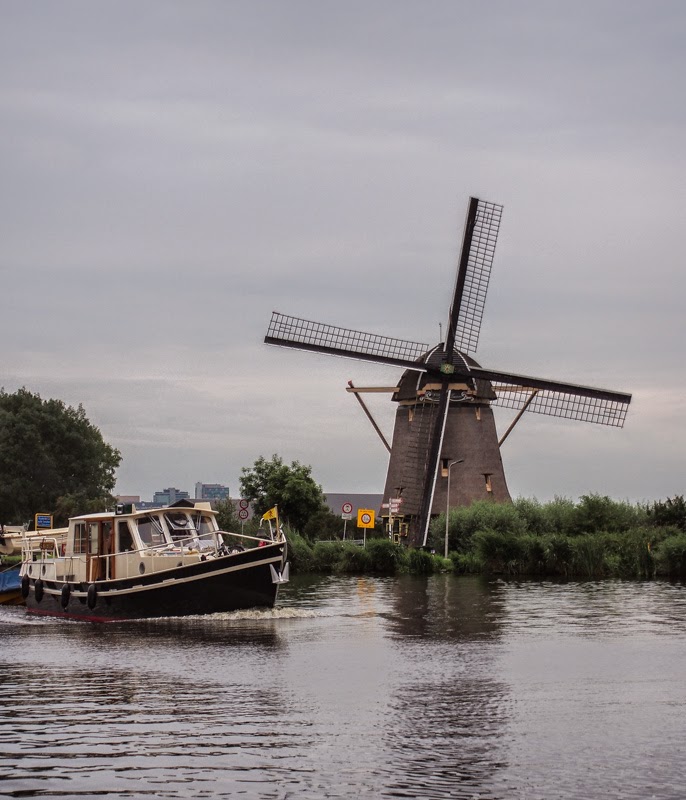 What?
What? A cycling trip through the Dutch countryside within a stone's throw from Amsterdam
Why visit?
As soon as you leave the city limits you enter a vista of classical Dutch landscape paintings, immortalised by Rembrandt and others.
Windmills? You got it. Water and boats? Yep. 18th century farmhouses and manors? Bob's your uncle. Cows? Moo!
And given how flat this country is, this trip is as easy as it gets.
Where?
Starting from the southern reaches of Amsterdam, we follow the Amstel river to the village of Ouderkerk aan de Amstel, about 8 km upstream. Map.
THE NAME AMSTERDAM was coined when medieval Dutchmen built a dam in the Amstel. And so what the Thames is to London, or the Seine to Paris, is the Amstel to the Dutch capital city. But here's the deal: follow the Amstel, and as soon as you pass the city ring road, you're in typical Dutch countryside. No grimy suburbs stretching for miles. No industrial estates. Just flat (very flat!) countryside.
So hop on a bike, and go Dutch!
 |
| The nuclear Dutch family: two parents, two kids, four bikes. |
 |
| If you don't like pedal power, you can always try peddle power. |
 |
| Zorgvlied is where the rich and famous hang out-eternally. |
 |
| Rembrandt sketching away. |
 |
| Shoot your own Dutch postcard, including typical Dutch grey skies. |
Want to cross over to the other side? Swimming is not recommend, so take the ferry that shuttles back and forth from the jetty right next to Rembrandt and his windmill. It costs €1. The ferry runs every day in summer, but only on weekends in winter. On on!
 |
| Ferry me across, please! |


Architecturally, there's plenty of eye candy- at least if you like traditional Dutch architecture. Back in Rembrandt's days, the wealthy few's must-have status symbol was a 'buitenplaats' (literally: outside place), a summer residence where one could escape the dirt and crowds of the city. The Amstel was a popular location, conveniently close to Amsterdam, and records indicate at least 70 buitenplaatsen were built by the wealhy burghers of Amsterdam during the 17th century.
A number of these buitenplaatsen still stand. At the beginning of the journey, just after the A10 ring road, you will have passed Amstelrust, which dates back to 1724. Another gem, Oostermeer, is located close to Ouderkerk. A typical feature is the theekoepel, a small domed pavillion where one could retire and drink tea, which the Dutch were the first to bring to Europe in the 17th century, and which was as expensive as Dom Perignon, so having a tea pavillion was an ostentatious display of wealth. They are usually located in a corner of the garden, facing the road (see and be seen!)
 |
| Oostermeer- the humble country house of a wealthy burgher. |
And finally, a suitably unusual sight. Just before number 65 on the Amsteldijk (still on the west bank), you will see, almost hidden in the bushes, a tall stone needle. It resembles a small obelisk, but doesn't look very Egyptian. It's a banpaal, a word that doesn't appear to have a direct translation in English, but loosely means 'banishment pole'.
Banishment was a common punishment in 17th century Amsterdam. If the authorities had had enough of your behaviour, you would be sent into exile, banished from the city, and forbidden to return for a certain period. (a similar thing happened to Romeo in Shakespeare's play). The banpaal indicated the limits of your exile- if you had been banned, you could not pass this marker, or else... The Latin inscription, Terminus Proscriptionis, indicates as much. There were banpalen on the main routes into Amsterdam, and this one dates to 1625.
 |
| This line thou shalt not cross- the 17th century banpaal (photo: wikipedia). |
Getting there:
Most Amsterdammers would argue there's nothing as dangerous as a tourist on a bicycle, but you really need your own or rented two-wheeler for this trip. The best starting point is the Amsteldijk near the President Kennedylaan, on the west bank of the river. If you return on the east bank, make sure you keep aiming for the tall Rembrandt tower near Amstel station.
Listen up: there are only three places where you can cross the river: at the A10 ring road (safe, but not very pleasant), in Ouderkerk (uneventful) and by ferry (opposite the Rembrandt statue; by far the best way).
Useful links:
Monumenten Ouder Amstel (in Dutch).
Oneindig Noord-Holland (in Dutch)


This trip happens every year through this route. plus you get to taste Noodles! http://www.meetup.com/NL-Adventurers/events/147680102/
ReplyDeleteGood review!! I see the greatest contents on your blog and I extremely love reading them.
ReplyDeleteThanks Yasmuna! You make us blush! Have you been to Amsterdam?
DeleteI will be visiting Amsterdam in a week. I think I will do this. Thanks for the detailed post :)
ReplyDeleteWe hope you'll enjoy it! Let us know how it goes!
Deletethis weblog is great
ReplyDeleteYou make us blush, Gregory! It's always great to hear people appreciate our site. Any specific sights you plan on visiting?
Delete